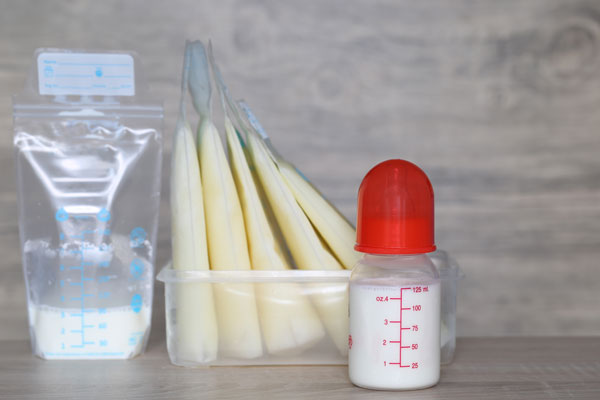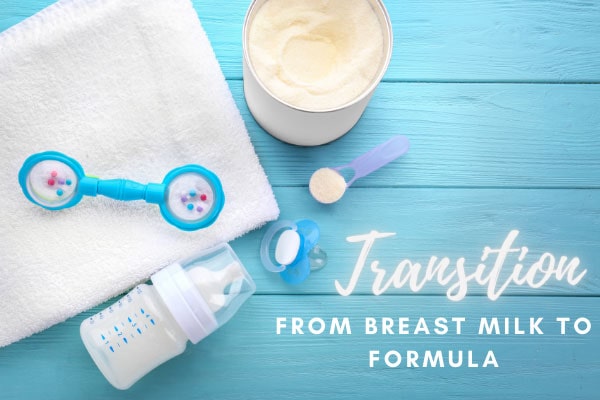Formula milk and breast milk, although both satisfy the nutritional needs of the baby, are highly different in taste and texture. Breast milk tastes tend to change with the mother’s diet, and formula milk tastes remain consistent. There can be several reasons for not liking formula, i.e., the baby is exclusively breastfed, switched the formula, or is not feeling well.
Apart from taste, there are numerous other factors that we can adjust to make the bottle feeding experience comfortable and pleasant for the baby.

How to make baby formula taste better?
The taste of the formula may be the source of rejection of the bottle because the formula contains iron that makes its taste metallic, and the fatty acids in it can impart a fishy smell. But the taste is not just about the flavors and textures.
The environment and the baby’s feelings and emotions also impact the taste of food. So before adjusting the flavor, you can try to modify the environment and look out for the cues given by your baby.
1. Mixing breast milk and formula milk
Suppose you are transitioning from breastmilk to formula milk. In that case, you can make this transition smoother for your baby by mixing the breast milk starting from 3:1 to 2:2, then 1:3, and finally eliminating the breastmilk. However, it would be best if you are cautious while mixing breastmilk and formula milk. It is not advisable to mix formula milk in breast milk.
For example, if your baby drinks four ounces, prepare one-ounce formula and then three ounces of breast milk. Gradually goes to two ounces formula and two ounces breastmilk and then goes for one-ounce breast milk added in three ounces of prepared formula. Finally, give the four-ounce formula milk to your baby. This way, your baby will gradually get used to the taste of formula.
One drawback to this strategy is that if your baby doesn’t finish the bottle, you have to discard leftover milk, and throwing breastmilk is quite hurtful to watch. So, make sure to prepare milk as per your baby’s hunger.
2. Different formula types
If your baby is altogether rejecting the formula bottle, you can try different formula types to assess your baby’s preference. Instead of buying complete tins, you can ask your fellow mommies for help.
You can also consult your pediatrician for the best formula and can ask for samples. You may have to test a few brands before finding the one that your baby likes. But in the end, it is worth it.
3. Prepare the formula following proper instructions
Make you are preparing the formula bottle following the proper instructions. Correctly measure the water and powdered milk quantity. Some brands use ounces, while some use milliliters as the scale of measurement for water.
Reading the formula, some asked specifically to add leveled spoon of milk while others give no such instructions. Sometimes, the bottles may have the wrong measurements.
It is also best to use clean water without any smell or flavor that can be off-putting for the baby. Sterilize the bottles before each feeding as the bacteria can be produced in the frequently used bottles and can produce foul smells.
Wash your hands and the counter before preparing the formula because any bacteria and the smell from your hands can add to the formula. Like if you were cooking and handled onion or garlic with a strong smell, the smell can seep into the milk from your hands.
The temperature of the formula should be right because some babies prefer room temperature while others like lukewarm bottles. Moreover the mix the formula properly. Some formulas take more time than others to dissolve in the water.
You should consider these steps while preparing the bottle, and these may sound too much, but once you get the hang of things, it will become a habit for you.
4. Look out for changes in the baby’s mood
As mentioned earlier, moods and feelings influence food choices and preferences. Following are the few inner states of your baby that can impact the drinking formula milk.
- Overtired
Some babies don’t like to drink milk when they are very tired; instead, they like to suckle for comfort. Comfort feeding is easy when the baby is breastfeeding, but it is not comfortable in bottle feeding. In that case, instead of the bottle, you can offer a pacifier to your baby and gives formula when he is hungry.
- Distracted
If your baby is too distracted to eat, he is more involved in playing or spending time with his grandmother or brother. Therefore, he will not be interested in feeding. So, if the baby is too distracted, let him play a little and then take him to a separate room for feeding.
- Ill or sick
If your baby is not feeling well, seek treatment for the problem. Meanwhile, give him the formula in small quantity but frequently. Don’t force-feed him and feed him when he is hungry.
Sometimes teething baby also doesn’t feel like drinking from the bottle, and the nipple can hurt his gums. In that case, look out for the soft nipple and give your baby a frozen teether to ease his discomfort.
- Aversion
Some babies are hesitant to drink formula because of discomfort like nausea, vomiting, or tummy ache experienced in the past. If this is the situation, gradually introduce the formula as suggested earlier. This will remove the fear of the baby, and he will willingly take the formula.
5. Check out the feeding schedule and dietary needs of the baby
Change in the feeding schedule is also significant in determining the baby’s preference for milk. Babies can change their feeding schedule without informing you, and you have to navigate using your skills and adjust the baby’s schedule. It is possible that his hunger shifted an hour earlier or later than his previously determined schedule.
Also, if the baby is ready for the solids, he will be fussy while drinking milk. If he is older than six months, introduce solids as per your pediatrician’s instructions, which will greatly improve their formula intake.
6. Adjust the feeding setting and environment
Settle a separate corner for the feeding. If you are transitioning from breastmilk to formula, try to give formula bottle yourself. It is also possible that your baby is missing some quality time with you.
You can have dim lights in your feeding area, can play soothing music, or sing rhymes for your baby. He will still experience closeness like in breastfeeding and will be more willing to accept the formula.
7. Change the nipple or feeding bottle
Sometimes, the baby is not comfortable drinking with specific nipples or teats of bottles. When you go to market, you can see a wide variety of nipples of different shapes and sizes. You can ask the salesman to guide you according to the age of your baby.
Nowadays, wide-mouth nipples are more in use and considered baby-friendly, but they also come in different styles. You can select the one best suited for your baby by trial and error method. Apart from the design of the nipple, nipple flow is also important. Some babies like to drink mouthfuls, while others prefer slow flow. Look out for the preference of your baby and select the nipple accordingly.
However, if the baby is still not like the formula, you can consult your pediatrician to change the brand that is closest to breast milk. However, if nothing is working for your baby and you are too desperate to add something in the bottle that can improve its taste, then keep reading.
What can you do to adjust the formula as per your baby’s taste?
If your baby is below six months, it is not advisable to add any sweeteners or flavors to the baby formula. This is because, before the six months, babies’ tummies cannot digest the outside flavors, and the addition of flavors can upset their stomach.
Adding rice cereal to the baby formula is considered an effective remedy for spit-up and reflux in babies. So you can try that for your baby but again if he is already taking the cereal on its own.
What to add to baby formula to make it taste better?
You may consider adding anything in your baby’s formula if he is more than six months. Some parents also add flavorings to the formula to make its taste pleasant for the babies. If your baby is already taking solids, you can try the following things in baby formula to make it taste better.
- Fruit purees
You can add the small amount of puree of the fruits you already introduced to your baby independently. This can make the taste of formula familiar for the baby.
- Fruit juices
If you are using juices to improve the flavor of formula, try to add fresh juice without sugar and preservatives that can be harmful to your baby.
- Vanilla essence
Vanilla essence is a mild flavor that can improve the taste of formula but make sure the vanilla essence you are using is non-alcoholic and organic.
- Spices
Some natural spices like cinnamon, nutmeg, cardamom, and fennel can also change the taste, and your baby may like it. But you should consult your pediatrician.
- Cereals
The addition of rice cereals in the formula is a remedy to reduce the GRE and spit up in babies. You can also try this remedy.
How to sweeten baby formula?
The flavoring mentioned above contains sugar in natural form and a small amount. The formula already has a sweet flavor because of the lactose. Doctors don’t recommend adding any sweetness to formula milk because it increases the chance of diabetes in the future.
Adding Karo syrup to baby formula for taste
You should not add honey or sugar before your baby hits the one-year mark. Some parents add Karo syrup or corn syrup or give a sweetness to the formula. However, doctors rarely suggest such a remedy because your baby may react to these sweeteners differently. Also, Karo syrup can cause loose stools, and your baby may be allergic to this.
These are the remedies, strategies, and tips based on personal experiences and the anecdotes of parents. Some of these remedies can work for your baby, while some may not. Therefore, you should be cautious while practicing these tips, use your personal judgment and consult your pediatrician where necessary.
Endnote
In this article, I reviewed the strategies that you can use to make the bottle feeding experience comfortable for your baby. If you are transitioning from breastmilk to formula, you can combine formula and breastmilk. You can change the brand of the formula and also can try different feeding nipples and bottles. Make sure your baby is not feeling sick, has a stuffy nose, sore throat, teething, or blisters in the mouth.
Ensure the environment is distraction-free and have prepared the formula bottle properly, following all the instructions. Sterilize the bottle regularly and make sure your hands are clean before preparing formula so that any residuals smell on your hand doesn’t transfer to the bottle.
If your baby is older than six months, you can add fruit juices, purees, vanilla essence, spices, and cereal in a feeding bottle to enhance the flavor of the formula. However, I don’t recommend you add corn syrup, karo syrup, honey, or sugar in the formula milk unless you get a green signal from your pediatrician.
Disclaimer: This article is based on opinions and experiences and doesn’t replace medical advice. Kindly use personal judgment while using any strategy mentioned in the article and consult your pediatrician where necessary.




